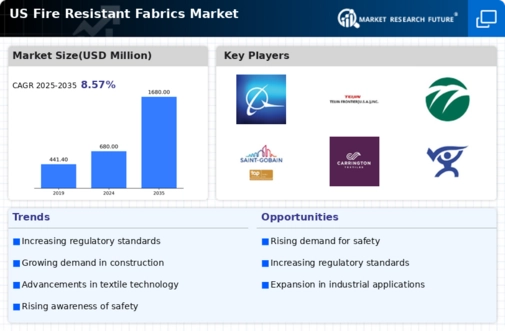The fire resistant-fabrics market is characterized by a dynamic competitive landscape, driven by increasing safety regulations and a growing demand for protective clothing across various industries. Key players such as DuPont (US), 3M (US), and Honeywell (US) are at the forefront, leveraging innovation and strategic partnerships to enhance their market positions. DuPont (US) focuses on developing advanced materials that meet stringent safety standards, while 3M (US) emphasizes its commitment to sustainability through eco-friendly product lines. Honeywell (US) is actively pursuing digital transformation initiatives to optimize its manufacturing processes and improve product traceability, collectively shaping a competitive environment that prioritizes safety and innovation.
In terms of business tactics, companies are increasingly localizing manufacturing to reduce lead times and enhance supply chain resilience. The market structure appears moderately fragmented, with several players vying for market share, yet the influence of major companies remains substantial. This competitive structure fosters an environment where innovation and operational efficiency are paramount, as firms seek to differentiate themselves in a crowded marketplace.
In October 2025, DuPont (US) announced the launch of a new line of flame-resistant fabrics designed specifically for the aerospace industry. This strategic move not only underscores DuPont's commitment to innovation but also positions the company to capitalize on the growing demand for specialized protective materials in high-risk sectors. The introduction of these fabrics is expected to enhance safety standards and could potentially lead to increased market share in the aerospace segment.
In September 2025, 3M (US) unveiled a partnership with a leading textile manufacturer to develop a new range of fire-resistant garments that incorporate advanced moisture-wicking technology. This collaboration highlights 3M's strategy to integrate cutting-edge technology into its product offerings, thereby enhancing the performance and comfort of protective clothing. Such initiatives are likely to strengthen 3M's competitive edge by appealing to a broader customer base seeking both safety and comfort in their protective gear.
In August 2025, Honeywell (US) expanded its portfolio by acquiring a small but innovative company specializing in smart textiles that offer real-time monitoring of temperature and exposure to hazardous conditions. This acquisition is indicative of Honeywell's strategic focus on integrating digital solutions into its product lines, which may enhance the functionality of fire-resistant fabrics and provide users with critical safety information. The move is expected to position Honeywell as a leader in the smart textiles segment, further differentiating its offerings in the market.
As of November 2025, current trends in the fire resistant-fabrics market indicate a strong shift towards digitalization, sustainability, and the integration of artificial intelligence in product development. Strategic alliances among key players are increasingly shaping the competitive landscape, fostering innovation and enhancing product offerings. Looking ahead, it appears that competitive differentiation will evolve from traditional price-based competition to a focus on technological advancements, sustainability, and supply chain reliability, as companies strive to meet the evolving demands of safety-conscious consumers.

















Leave a Comment